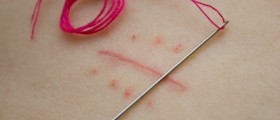
What are keloids?
A keloid is a type of scar, which results from the overgrowth of thick fibrous tissue as the skin heals from an injury. A keloid extends over the borders of the original injury or wound, rarely goes away or subsides spontaneously and often comes back after surgical removal.
Keloids are made of collagen. Type 3 or early collagen is formed at the wound site soon after the wound starts healing. This type of tissue than becomes replaced with type 1 or late collagen. Keloids are firm, rubbery, in form of lesions or nodules. Their color can be pink, flesh-colored, red, light brown or dark brown.
Like all scars, keloids are benign. They are also not contagious, although they may seem so, because they often cause itching. They can also be painful.
Keloids should not be confused with hypertrophic scars which do not extend over the boundaries of the wound and often fade away or disappear completely without any treatment.
Like all scars, keloids are more of a cosmetic concern than an actual heath problem, especially if they are located in a highly visible place, such as the face, hands, arms, neck or shoulders. However, these scars sometimes cause contractures, which may cause some difficulty if they are located over a joint.
Although anyone can have keloids, they are relatively rare in very young children and old people.
Treatment for kelodis
Some people seem to be predisposed to keloids. For them, the best treatment would be prevention of injuries or elective surgeries that can lead to such scarring.
The first-line therapy for keloids is the injection of corticosteroids directly to the lesion. If that does not help, surgical incision of the tissue may be performed. However, there is no guarantee that the incised tissue will not come back again. Some experts believe that interferon alpha injections can reduce the chance of recurring keloids.
Cryotherapy or freezing the keloid off is also an option, as well as laser surgery. Silicone gel sheeting or covering the keloid with this gel is recommended for relieving pain and itching, as well as for preventing the keloid from growing bigger.
Radiation therapy is currently being explored as a treatment option of keloids that keep coming back after surgical or laser removal or keloids that are very large and unresponsive. However, the problem with radiation therapy is that there is still no knowledge about the long-term effects, such as increased cancer risk.

















Your thoughts on this
Loading...